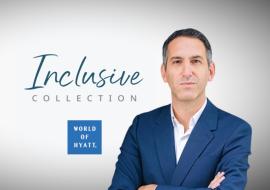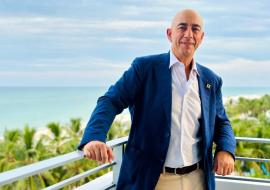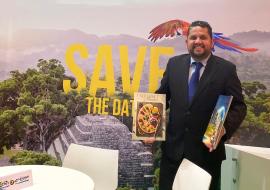Antonio Diaz Medina. Deputy Director of Havanatur and Manager of Celimar Travel Agency


Q- How long have you been manager of Celimar?
<i>A- I’ve been at the helm of Celimar –a division of Havanatur dealing with flights between the U.S. and Cuba- for the past four years. Before that I worked overseas as a diplomat, and I think that gave me some kind of experience, as least as a customer. </i>
Q- Can you refer to the features these flights have, the motivations behind them and the main customers?
<i>A- Above all, I must say last December we celebrated the 25th anniversary of the first flight between Cuba and the U.S. after relations between both countries were broken. Those first flights weren’t direct, but through Jamaica. Beginning with the Carter administration –his White House took a very realistic stance in the face of objective conditions at the time- flights got cracking initially to shuttle Cuban residents in both countries and based on the undeniable human right to family reunification. That’s how travel between the two nations began. Cuban residents in the U.S. had the chance of visiting their relatives on the island, and many islanders traveled to the U.S., too. Those flights have also been used to channel legal and ordered migration as it happens in any other country around the world. Before these flights began, the entire process was uneven because it used to be carried out through third countries or aboard illegal and highly dangerous means.
Since the mid 1990s, this possibility came around and a few Americans started coming to Cuba for very particular and concrete reasons, either linked to political activities, scientific events or major artistic gatherings. From 1999 on, the picture of aviation operations began to shift for the better as we jumped from 5 percent of American citizens that flied to Cuba in those first flights to a staggering 25 to 30 percent, even in spite of the travel ban still in force. On the other hand, the practice of visiting Cuba through third countries remains in place, in some cases due to better air connections and in others because some Americans without licenses issued by Washington to come to Cuba try to get around travel restrictions. Those are people willing to and interested in coming to Cuba. In a word, we can say that beginning in 1999, we started a major increase in the number of U.S. citizens traveling to Cuba. </i>
Q- Does the main goal of these trips continue to be business matters, bilateral relations and family reunions?
<i>A- In the case of Cubans, family exchange is the nitty-gritty factor. But as far as Americans are concerned, the list of interests is way too long. In terms of business, and over the last couple of years when a fledgling trade of foodstuffs got underway, scores of businesspeople have come to Cuba. Around 700 of them took part in an important tradeshow held here last year. But the largest chunk of Americans traveling to Cuba is intellectuals, mostly middle-class or high middle-class people, persons who want to take a firsthand look at Cuba’s reality all by themselves. Culture is no doubt one major segment of that market, given its features and the number of historic exchanges between Cuba and the U.S. Many professionals travel, too, lured by Cuba’s achievements in such outstanding sectors as education and healthcare.
Some lawyers come to Cuba interested in scouring all of Cuba’s legal loopholes and watching trials, learning about legal proceedings, seeing the way law firms operate and witnessing the characteristics of the Cuba democracy. They come down with a different perspective and leave this country convinced that our legal system is different to theirs, but that an in-depth look at it is required in order to have an objective and respectable understanding of it.
Lots of these professionals have left favorably stunned by Cuba’s achievements in these sectors, regardless of the many limitations that we have and we never try to hide. We lay bare those limitations before their eyes and these are very sensitive people we’re talking about, professionals with great ability to appreciate things.
It’s indeed regrettable that the current travel ban has limited the issuing of licenses to those people to the utmost. As far as we are concerned, each and every person or customer is a new challenge to us because their interests are wide apart from those of traditional tourists. For them, getting to know Cuba is the name of the game. They come here to see how the Cuban society is actually like, to know its laws, the way people live. Many visitors eventually become advocates of lifting the U.S. travel restrictions on Cuba. </i>
Q- Are there any particular states or regions that stand out as senders of this kind of traveler?
<i>A- In the case of Cubans, we know where they come from, I mean, South Florida, New Jersey, NYC and California.
Americans, for their part, come from all across that huge country, but chiefly from the Mid East, New England, New York, Massachusetts, and around Washington D.C., though some also come from the western side of the nation where plenty of filmmakers, musicians, fine artists and museologists live. Over a thousand Americans from several parts of the country came to Cuba during last year’s Biennial of Fine Arts. By and large, some of Cuba’s major events, such as the Jazz Festival, the International Cinema Festival and the Biennial of Fine Arts are highly sought after by U.S. citizens, because they know they’re going to find here what they’re looking for, not in terms of certain cultural products to buy, but rather knowledge about trends on those topics about Cuba and about all the countries gathering here for those events. This kind of traveler leaves the country deeply pleased and he’ll always be a part of a highly coveted market segment to us. </i>
Q- Is there any kind of special warranty for this category of traveler?
<i>A- Cuba is one of the world’s safest nations and these visitors know that pretty well, they can feel it. Here they can do things they can’t do in their own country, either in broad daylight or at night, like roving the streets freely, for instance. In a number of countries worldwide, even in some major tourist destinations, there are the so-called tourist ghettos for a number of reasons, even for some that can’t be worked out. This never happens in Cuba where people are incredibly friendly. Besides, trippers chance upon services and people that they don’t expect to find. They’re stunned by the educational level of the Cuban people, especially of ordinary citizens, their language skills –something which is very important when it comes to communicating and getting information. Both businesspeople and those who come here looking for leisure, leave the island nation amazed by the people’s cultural and educational levels. </i>
Q- Does Celimar operate in coordination with any other Cuban company or enterprise?
<i>A- Havanatur Celimar belongs to CIMEX, perhaps the country’s largest company in terms of sales volume. For the U.S., we’re only a receptor, even though we act as a tour operators and receptor in other markets. We’re Cuba’s only receptive company and all of the services are ours. We rely on a transportation base featuring 165 top-of-the-art buses, the finest team of guides there is, and a wide and comprehensive infrastructure all around the country. We embrace all tourist destinations, so that gives the operational edge of responding to any circuit or program, no matter how far-reaching it might be, from Baracoa to the Viñales Valley. We’ve got what it takes in terms of transportation and assistance, with well-trained personnel and services not exclusively limited to travel circuits that can be enjoyed in a number of different locations.
The reason for our coming into being 25 years ago was the U.S. market, but our outreach has enhanced dramatically ever since. Our operations are now branched out all over the globe, broken down in approximately 30 percent with the United States and the remainder with other highly-demanded markets, such as Canada. </i>
Q- Does your company have some kind of representation in the U.S. for conducting its operations?
<i>A- We had a representation up there for a brief period of time during the Carter administration. Then legal restrictions forced us to remove that representation. We count on a network of collaborators, tour operators and charter planners we work with. We’re related to seven charter companies and nearly 50 or 60 U.S. agencies, mainly those chartering aircraft in the U.S., for that particular operation. These relations have expanded, mostly to other travel agents, though the megabuck tour operators that move millions of travelers –especially to sun-and-beach destinations- are still out of the picture. In our particular case, we keep on putting our smart money on the future of the segments we mentioned above. We want to groom them and get a toehold on them as a company. You bet they stand for quite a challenge to us, and we’re interested in them. </i>
Q- Can you talk about what airlines you operate with and everything linked to flight timetables?
<i>A- In the U.S., we basically operate with four airlines. Negotiations have taken us too long, but after three years of hardworking we’ve managed to improve the quality of air operations dramatically. Today, we’ve got ties with the country’s top-four air carriers; we rely on the best planes money can buy, and timetables are just fine for any kind of regular operation. We cannot say air operations are completely regular right now because the embargo raises too many hurdles along the way, but those ties are getting stronger and stronger with each passing day, especially on issues that are hard to pass up, like passengers’ security and good services to people who’ve got nothing to do with the political decision-making. We’ve managed to talk some sense into the U.S. government in this respect and American authorities have understood all this in a more rational way. </i>
Q- Does the company have a website?
<i>A- We’ve got this website, www.havanaturcelimar.com, mostly dealing with information and targeting the U.S., and www.havanatur.cu, which is the all-embracing portal of Havanatur. Both sites are hyperlinked to www.havanaturcelimar.com. We’re remodeling and improving the site to upload all relevant information on our travel products. We’re talking about tourist products in the widest sense of the word, say, lectures by experts from Cuba’s Ministry of Foreign Investments, the Ministry of Public Healthcare, exchanges with legal experts about the Cuban Constitution, that is, things you’re not going to find in any brochure and that we must show to those in America with licenses in their hands to travel to Cuba, so they can plan their own interests beforehand.
There’s been great interest lately in issuing licenses to religious groups. This is something very interesting and as long as no second thoughts are intended and no Cuban legal provision is breached, it stands for a good chance to exchange mutual views on cultural and social topics. Except for a handful of rare occasions, we can say most of these institutions and religious people from both countries have common interests to share experiences and make friends with one another in a perfectly sound and enriching way.
As to the online sale system, we don’t have one because the U.S. Department of the Treasury keeps tabs on those people who travel legally to Cuba. In order to have an online sale system, we are bound to create and legalize all mechanisms and function as a company based in the United States, something which is not possible to do right now. However, there are travel agents making offers online the moment they sell travel packages previously coordinated with us, especially college programs and packages for professionals who make online reservations and bookings. </i>
Q- Would you like to put a general message across to those surfing this website?
<i>A- Yes. I’d like to explain that, objectively speaking, growth opportunities for the U.S. tourist market are determined by the political restrictions imposed by Washington. We’re ready to assimilate any shift this market might take, either a nosedive or an upturn. Either way, we’re oiling our marketing systems, streamlining our management lines and painting a much clearer picture of the Cuban product to that particular destination.
Negative situations and crises have taught us that it’s a whole lot better to showcase the Cuban society than to present the country’s natural beauties. That stirs up the intellect, enriches creativeness and stimulates us, too.
Cuba is a mega-destination perched on the Caribbean, yet it differs from the traditional Caribbean destination. We use the word “mega-destination” because we believe it’s got all the attractions any other nation in the world does, because of its size and natural features. But, above all, we say it because of the exceptional quality of its culture and society.
Basically our message is that we’ll keep on making the services we offer a whole lot more efficient every step of the way. </i>














